All About Green, Lime and Olive Sea Glass
Not just a bottle… the many hues of green sea glass…
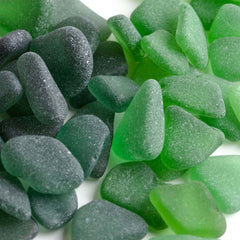 There are more shades, tints and hues of green than any other sea glass color. From the duskiest of dark olive to the vivid flash of lime, it can sometimes seem to the avid sea glass collector that no two pieces of green sea glass are exactly the same color!
There are more shades, tints and hues of green than any other sea glass color. From the duskiest of dark olive to the vivid flash of lime, it can sometimes seem to the avid sea glass collector that no two pieces of green sea glass are exactly the same color!
Green glass, in one shade or another, has been made for almost 3,000 years. Most of the time in days gone by, this glow of green occurred “naturally” due to the mineral impurities that were present in the glassmakers sand. And green glass can take on a different hues when minerals are added at different points in the glass making process.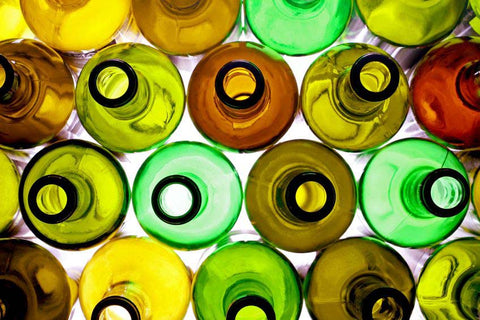 Chromium, iron and copper all produce green glasses, but the amount of each gives subtle differences… from yellow green, apple green, citron, Kelly green and jade green to the vibrant 7-up green. (Yep, named for the soda pop – their bottles used to be glass in that bright green.)
Chromium, iron and copper all produce green glasses, but the amount of each gives subtle differences… from yellow green, apple green, citron, Kelly green and jade green to the vibrant 7-up green. (Yep, named for the soda pop – their bottles used to be glass in that bright green.)
Then, of course, someone had to add cobalt to the mix (the same cobalt used to make blue glass) and create a whole family of teals, blue-greens and peacock greens.
For more on these blue greens, see All about Aqua, Turquoise and Teal Sea Glass here>
No matter what the color, green sea glass is a joy to find. Each piece reflects its own version of nature’s neutral… green.
All About Forest, Jade and Kelly Green Sea Glass
 Green glass has been in constant production since the 1700s… but as is true with all things green glass, the specific hue, shade or tint is all important!
Green glass has been in constant production since the 1700s… but as is true with all things green glass, the specific hue, shade or tint is all important!
And, here is a little hint when it comes to green sea glass. Generally, the deeper the green, the older the glass. And, the thicker the sea glass, the older it is. (Glassware was hand-blown back in the day, and had thicker walls and bottoms.)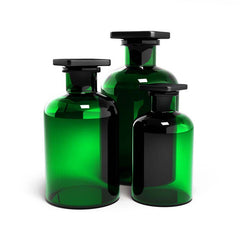 In fact, a discussion of green sea glass really should begin with “black” sea glass, which almost always has an amber or green hint to it. But, for more on that, see All About Black Sea Glass here>
In fact, a discussion of green sea glass really should begin with “black” sea glass, which almost always has an amber or green hint to it. But, for more on that, see All About Black Sea Glass here>
Dark forest green shades of sea glass are the rarest of the true greens. Deeper in color than jade green, forest green glass tends just a bit to the yellow side. Thicker shards harken from a time when hand blown bottles in this color was used to protect liquors like gin from the harmful rays of the sun. However, as anyone who likes their wine will tell you, this color is still used by vintners today.
 Jade green sea glass resembles the color of emerald gemstones. Rich and glowing, this green was a favorite of glassmakers for 150 years. With a depth of color you don’t see in the lighter Kelly green, jade green was most often used for bitters and mineral
Jade green sea glass resembles the color of emerald gemstones. Rich and glowing, this green was a favorite of glassmakers for 150 years. With a depth of color you don’t see in the lighter Kelly green, jade green was most often used for bitters and mineral
water bottles, flasks and even poison bottles in the mid-to-late-1800s. Then, in the early-to-mid-1900s jade again made an appearance in bottles, jars and Depression era decorative glass. Remember the sea glass mantra, the thicker, generally speaking, the older!
Cheerful Kelly green sea glass is the most familiar to the 21stcentury sea glass seeker. If you’ve taken a stroll down the soda or beer isle in the last 50 years, you’ve seen bottles in this light, clear shade of pure green. (OK, so most soda bottles these days are plastic, but remember, decades ago they used to be glass.) Sometimes called 7-up green after the classic soda bottles, most Kelly green glass is thinner and curved, giving hints as to its original form.
Depending on the thickness, Kelly green sea glass ranges from rich bright green to the springtime pastel tint we love. It is this green that the last few generations of sea glass hunters were most likely to discover.
Green Sea Glass – 5 Fascinating Facts
 1. Forest green is the darkest of the true greens, jade the most vibrant, and Kelly green the most varied in color.
1. Forest green is the darkest of the true greens, jade the most vibrant, and Kelly green the most varied in color.
2. Old time mineral waters of the 1800s were bottled in the same greens that Pellegrino and Perrier – of course, Perrier has been around for 150 years!
3. Bottle collectors not only have myriad names to describe green glass, they also use modifiers like dark, deep, medium, light, bright, vivid… you get the idea – there are just a lot of greens!
4. Green was a popular color for pharmacy bottles in the early 1900s.
5. The first bottled mineral water was bottled in 1622!
Green Sea Glass Jewelry
 Green is nature’s neutral. Since the dawn of time green has symbolized growth, freshness and harmony. Green is a universal color for safety and security.
Green is nature’s neutral. Since the dawn of time green has symbolized growth, freshness and harmony. Green is a universal color for safety and security.
Green is the most restful color to the eye, and is said to have great healing power. Hopeful and vibrant, green is refreshing to wear and to be around.
Reach for your green sea glass when you are seeking endurance, healing and protection. Green has the unique ability to both calm and alleviate stress, while invigorating the wearer.
Lime Green Sea Glass
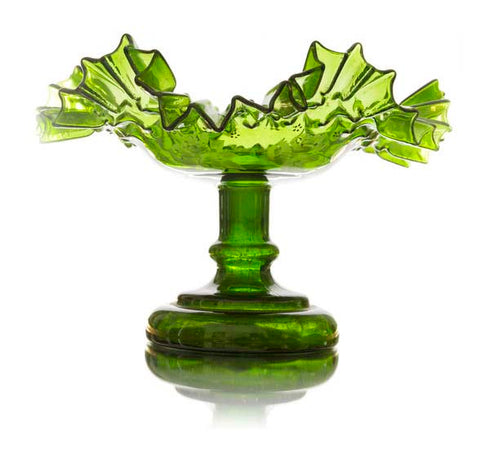 Sunny, glowy lime green combines the vibrant green with a touch of pure yellow to give this sea glass color an almost neon brightness. This bright lime-green color that sometimes makes an appearance on the sea shore is almost always from glass produced in the twentieth century. Sometimes referred to as “soda pop green” this sea glass is lighter and brighter than its forest, jade and Kelly green counterparts. It has a distinct yellowish hue and is quite alluring.
Sunny, glowy lime green combines the vibrant green with a touch of pure yellow to give this sea glass color an almost neon brightness. This bright lime-green color that sometimes makes an appearance on the sea shore is almost always from glass produced in the twentieth century. Sometimes referred to as “soda pop green” this sea glass is lighter and brighter than its forest, jade and Kelly green counterparts. It has a distinct yellowish hue and is quite alluring.
Lime green sea glass is perhaps the only sea glass color that is a direct nod to the contents inside – most often the lemon-lime soda pop of the last half of the 20thcentury. Freska, ginger ale, Squire and Sprite have all be bottled in this color… and sometimes even 7-up, who’s bottles range from Kelly green to lime.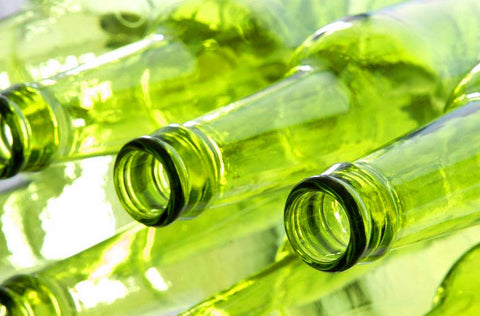 In some areas, lime green sea glass comes from location-based manufacturing. For example, Coco Rico, a coconut soda made in Puerto Rico, is packaged in lime green bottles. These may wash up as thin pieces of sea glass around the region and in Florida. In contrast, darker green found on California beaches is more likely to come from wine bottles.
In some areas, lime green sea glass comes from location-based manufacturing. For example, Coco Rico, a coconut soda made in Puerto Rico, is packaged in lime green bottles. These may wash up as thin pieces of sea glass around the region and in Florida. In contrast, darker green found on California beaches is more likely to come from wine bottles.
Because lime green sea glass comes mostly from bottles just decades old, it tends to be smaller than older, thicker shards. Modern glass manufacturing allows for thinner-walled bottles. The bonus is that this thinness heightens the lime green color, creating one the brightest colors in the sea glass world.
Lime Green Sea Glass – 5 Fascinating Facts
 1. About 95% of all lime green sea glass comes from bottles.
1. About 95% of all lime green sea glass comes from bottles.
2. Because most lime green sea glass comes from soda pop bottles, we can guess at it’s age – the late 1940s when soda pop became wildly popular, to the 1970s, when most manufacturers switched to plastic bottles.
3. In just a few rare cases, lime green sea glass comes from older pharmacy or milk bottles from the early 20thcentury.
4. Sometimes lime green is confused with UV or Vaseline glass – but UV usually has more yellow in it and is significantly lighter and less vibrant than lime (unless of course, you have a black light on hand!) For more information on UV sea glass, click here>
5. It is still possible to discover lime green sea glass bottle neck fragments with a raised lip for the metal top.
Lime Green Sea Glass Jewelry
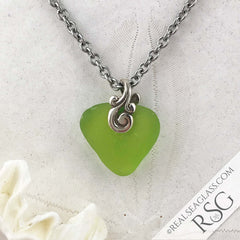 Lime green is one of the brightest colors in the sea glass family, and brings that sunny pop of color known for bringing spontaneity and excitement.
Lime green is one of the brightest colors in the sea glass family, and brings that sunny pop of color known for bringing spontaneity and excitement.
Said to be the color of happy anticipation, lime green is associated with the first leaves and buds of spring, heralding change, rebirth and growth.
Lime green sea glass has an attitude all its own. Wear this color on the days you are ready to welcome new adventures with a cheerful, calm optimism.
All About Olive and Citron Green Glass
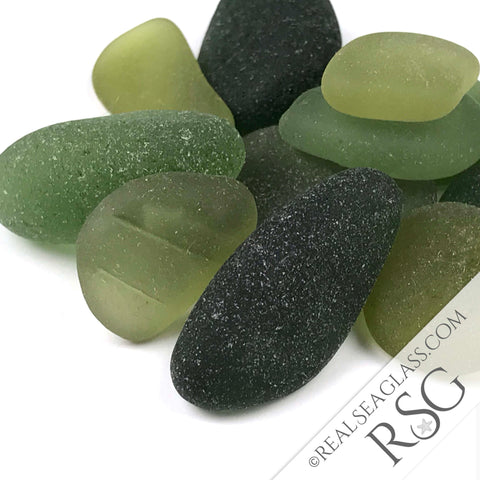 Generally speaking, the yellow-green glasses with shades of black are the oldest of all the green sea glass pieces we discover. The color alone reminds us of days-gone-by. In fact, most “black” sea glass has a distinctive dark green glow when held to the light. (For more on black sea glass click here>) Most dull olive green colored sea glass is pre 1900, while brighter olive green is often from 20thcentury wine bottles.
Generally speaking, the yellow-green glasses with shades of black are the oldest of all the green sea glass pieces we discover. The color alone reminds us of days-gone-by. In fact, most “black” sea glass has a distinctive dark green glow when held to the light. (For more on black sea glass click here>) Most dull olive green colored sea glass is pre 1900, while brighter olive green is often from 20thcentury wine bottles.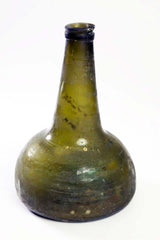 Just like all the other green sea glass hues, olive green glass has a host of names – pea green, yellow-olive, olive-yellow, olive emerald green and amber-olive just to name a few. These colors were regularly produced from the late 1600s for alcohol bottles. Rum, gin and even scotch bottles as well as flasks were produced in mass and throughout Europe, and later the U.S. and Canada and shipped all over the world. And, of course, vintners still love the bright olive greens for their wines.
Just like all the other green sea glass hues, olive green glass has a host of names – pea green, yellow-olive, olive-yellow, olive emerald green and amber-olive just to name a few. These colors were regularly produced from the late 1600s for alcohol bottles. Rum, gin and even scotch bottles as well as flasks were produced in mass and throughout Europe, and later the U.S. and Canada and shipped all over the world. And, of course, vintners still love the bright olive greens for their wines.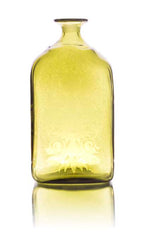 A cousin of olive – the lighter citron green – was popular in the late 1800s and early 1900s for wine and other bottles. Citron green has a deeper green tone than vibrant lime and was used in the 1800s for specialty bottles as well as wine. Ink and bitters bottles were sometimes made in citron green. In the 1900s, this color is often associated with olive oil bottles, reflecting the color of the olives used to make the oil.
A cousin of olive – the lighter citron green – was popular in the late 1800s and early 1900s for wine and other bottles. Citron green has a deeper green tone than vibrant lime and was used in the 1800s for specialty bottles as well as wine. Ink and bitters bottles were sometimes made in citron green. In the 1900s, this color is often associated with olive oil bottles, reflecting the color of the olives used to make the oil.
Olive green sea glass ranges from the lightest of citrons to almost black. Thicker pieces almost always signal an older bottle, and sometimes bottle bottoms, necks and tops will give the sea glass hunter a clue as to the age and use of the bottle that their sea glass comes from.
Olive Green Sea Glass – 5 Fascinating Facts
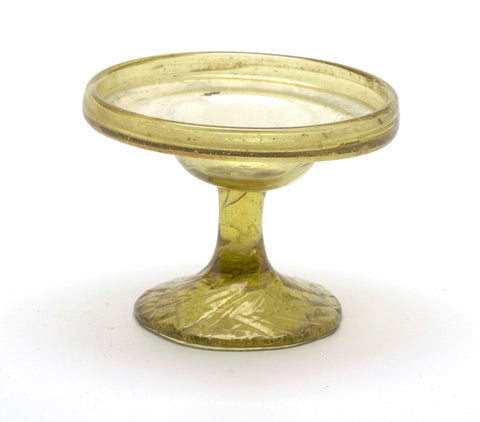 1. Antique citron bottles can be more valuable than their darker olive cousins.
1. Antique citron bottles can be more valuable than their darker olive cousins.
2. Olive green sea glass with a slight amber hue is almost always pre-1900 in origin – the one in this picture dates to 300 AD!
3. Iron slag is often the ingredient that makes dark olive sea glass dark.
4. Discovering olive sea glass can be a challenge because it often looks just like the rocks surrounding it.
5. If you hold your olive or citrine sea glass to the light and see bubbles, it is most likely from a pre-1900 hand-blown bottle!
Olive Green Sea Glass Jewelry
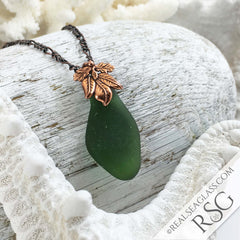 Olive green is the color of balance… the combination of the vitality of bright green and the security and purpose of its darker tone.
Olive green is the color of balance… the combination of the vitality of bright green and the security and purpose of its darker tone.
The color of money, olive green is associated with financial stability and success and abundance in every area of live. Closely tied to nature, olive green soothes anxiety and offers a sense of well-being.
Olive sea glass jewelry is perfect for the day you’re looking for that added bit of luck, paired with growth and progress. Olive also unites harmony and wisdom for clarity of purpose.
Is Green Sea Glass Rare?
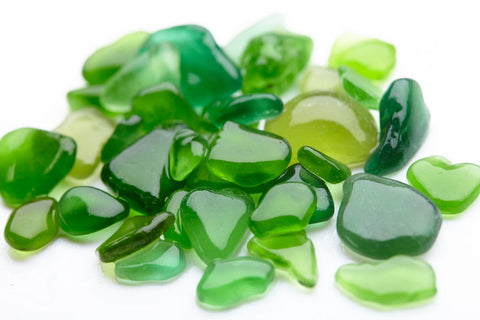 Yes… at this time, sea glass in general is a vanishing treasure, but each green has a different rarity! Soft hues of Kelly green are less limited than limes, citrons and olives. And again, forest and jade are far rarer than Kelly green.
Yes… at this time, sea glass in general is a vanishing treasure, but each green has a different rarity! Soft hues of Kelly green are less limited than limes, citrons and olives. And again, forest and jade are far rarer than Kelly green.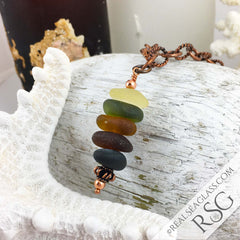 Sea glass rarity is about three things: color, quality and frost. A more less limited color that is completely rounded and frosted is more valuable than a rarer color that is not what we call “fully cooked” – perfectly sea frosted and rounded to perfection.
Sea glass rarity is about three things: color, quality and frost. A more less limited color that is completely rounded and frosted is more valuable than a rarer color that is not what we call “fully cooked” – perfectly sea frosted and rounded to perfection.
The good news is that the rarer sea glass colors of forest, jade, olive and citron are often the oldest – the sea has worn them to surf-frosted perfection. Only real sea glass has this time-worn texture and inner glow… manufactured frosted glass just can’t reproduce the subtle sea etching and fascinating history of a true sea glass rarity.




